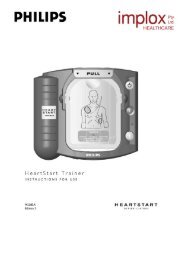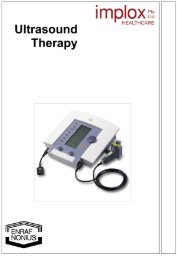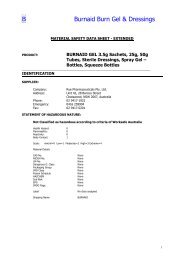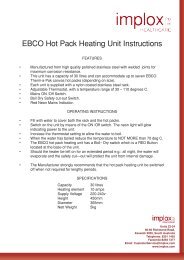intraosseous infusion - Implox
intraosseous infusion - Implox
intraosseous infusion - Implox
You also want an ePaper? Increase the reach of your titles
YUMPU automatically turns print PDFs into web optimized ePapers that Google loves.
LaRocco and Wang IO INFUSION 281<br />
FIGURE 1. Anatomy of long bone circulation and landmarks for<br />
<strong>intraosseous</strong> needle insertion (access site) on the proximal tibia.<br />
venous sinusoids within the medullary cavity, drain<br />
into the central venous channel, and exit the bone via<br />
nutrient or emissary veins (Figure 1).<br />
INDICATIONS AND CONTRAINDICATIONS<br />
The basic indication for IOI is the need for emergent<br />
vascular access when conventional methods have<br />
failed. The American Heart Association recommends<br />
the use of IOI in patients under 6 years of age in need<br />
of vascular access who have had two failed IV<br />
attempts or where more than 2 minutes have elapsed<br />
at attempting IV access. 6 Advanced Trauma Life<br />
Support protocols recommend the use IOI before central<br />
line insertion in pediatric trauma patients younger<br />
than age 6. 2 The use of IOI in major trauma in pediatric<br />
patients regardless of age has also been supported<br />
by Guy et al. 16 IOI has also been recommended for<br />
conditions such as cardiopulmonary arrest, profound<br />
shock, status epilepticus, overwhelming sepsis, and<br />
major burns. 17,18<br />
The only universally accepted absolute contraindication<br />
to IOI is a fracture of the bone near the access<br />
site. 19 Some authors feel that osteogenesis imperfecta<br />
and osteoporosis should also be considered absolute<br />
contraindications. 20 Relative contraindications to IOI<br />
include cellulitis over the insertion site and inferior<br />
vena caval injury. 19<br />
TECHNIQUES OF INSERTION AND INFUSION<br />
The conventionally recommended site for IOI is the<br />
proximal tibia. 2 The tibial tuberosity should be located<br />
by palpation just below the patella. The recommended<br />
insertion site is the relatively flat area approximately 2<br />
cm distally and slightly medial to the tibial tuberosity<br />
(Figures 1 and 2). Although this site is usually distal to<br />
the growth plate, it is still recommended that the nee-<br />
FIGURE 2. Technique of <strong>intraosseous</strong> needle insertion in the proximal<br />
tibia.















